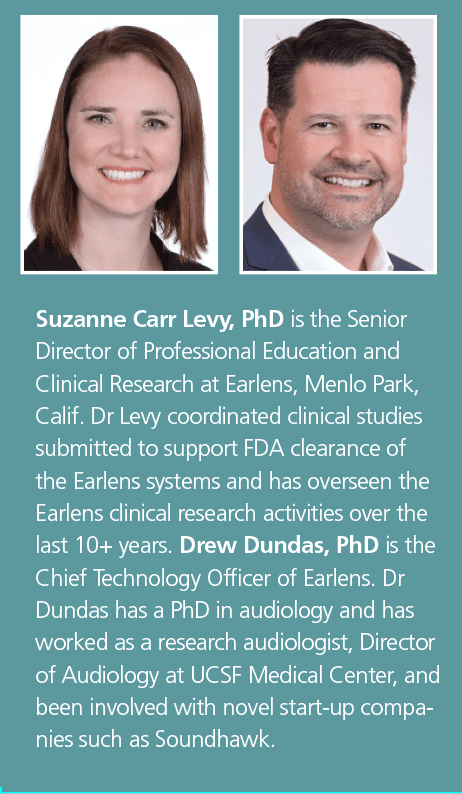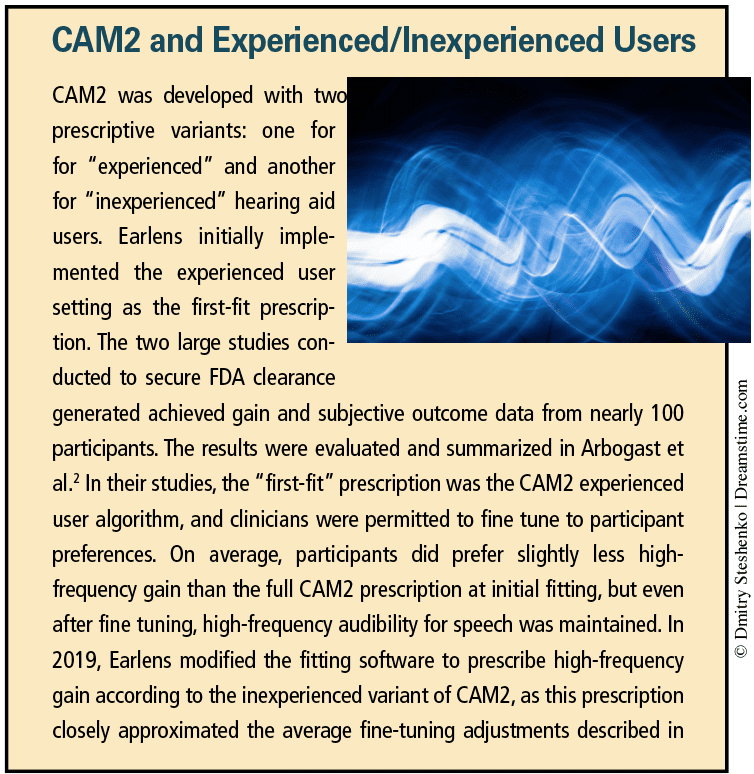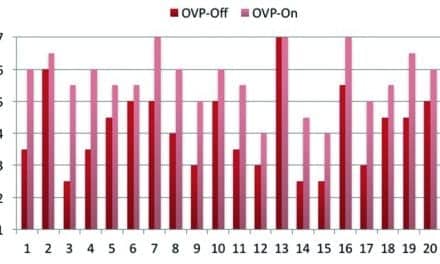Tech Topic | January 2022 Hearing Review
By Suzanne Carr Levy, PhD, and Drew Dundas, PhD
This 3-part series is intended to serve as a high-level review of the data that has accumulated across more than 10 years of clinical research with the technology at the heart of the Earlens system. In Part 1, we dove into the speech understanding data and how increasing the bandwidth of processed audibility results in improved speech understanding performance from a number of perspectives. In Part 2, we discuss the perceptual benefits to naturalness and overall sound quality. Finally, in Part 3, we’ll deep dive into the restoration of audibility, and how the Earlens approach to overall audibility improvement is reliably achieved via direct drive.
Anecdotal reports of superior sound quality and superior speech understanding have been common since the first clinical evaluations of the Earlens system. As noted in Part 1 of this article series,1 clinicians from early studies were persuaded by persistent participant testimonials that Earlens had better sound quality than acoustic devices. However, one question of great speculation has taken years to answer: “Given our clinical experiences attempting to provide broadband audibility with acoustic devices, why aren’t Earlens patients complaining of tinny and harsh sound quality when as much as 60 dB of insertion gain is needed to restore high frequency audibility?”
To this day, we meet clinicians who express skepticism regarding the value of broadband audibility. After all, pushing the limits of conventional devices to extend the audible bandwidth into the high frequencies commonly leads to reports of harshness and a quick request to “turn it down, please!” rather than exclamations of delight and reports of a dramatic improvement in sound quality. So, while we would all agree that research shows that delivering a broader bandwidth of audibility is “better” in terms of potential speech perception benefits, those benefits will not be realized if sound quality or preference issues lead users to leave their devices in the drawer or force the clinician to turn the gain down.
Summary of Sound Quality and Subjective Preference Studies
Repeated studies utilizing subjective preference questionnaires demonstrate that the sound delivered by the Earlens system is perceived as being clear and natural, with exceptional sound quality. Subjective reports of superior speech understanding and improved satisfaction relative to acoustic hearing aid performance have also been documented.2,3 Using a blinded comparison approach, Folkeard et al,4 showed a significant preference for the sound of wide-bandwidth speech, demonstrating that the provision of high-frequency audibility does not degrade sound quality. Vaisberg et al5 further demonstrated that extending the high frequency audible bandwidth from 5kHz to 10kHz produced consistently superior ratings of the sound quality of both speech and music.
Despite this accumulation of evidence, many clinicians remain surprised that Earlens patients seem to not only tolerate, but consistently prefer, a level of high-frequency amplification and audibility that an acoustic hearing aid patient may not be willing to leave the office with, even if it were possible!
So, is there something “magical” about direct drive? Is the reason purely extended bandwidth? Or is there something else?
“The Pedestal of the Lows”
Over the years, we’ve gained insight into some of the reasons why Earlens users enthusiastically accept high-frequency audibility. In short, it may correlate with Earlens’ ability to provide low frequency output while maintaining a widely vented configuration—which is possible due to the unique mechanism of action of directly driving the eardrum. This low-frequency energy provides the pedestal that is required to generate acceptance of the high frequencies.
The importance of the low frequencies and the ability to achieve them through the direct drive mechanism is perhaps most evident in comparisons of streamed audio sound quality. Even while vented, the Earlens streaming program can supply ample low-frequency output to provide rich bass sounds, which creates a significant streaming sound quality advantage over vented acoustic hearing aids.6,7
But does the low frequency advantage apply in other listening situations outside of streaming? Moore and Tan8 showed in normal-hearing listeners that, when you start with a bandwidth which approximates that of a conventional hearing aid (313-4455 Hz), sound naturalness ratings are poor. Simply extending only the lows or only the highs does not appreciably increase naturalness. However, extending both the lows (down to 55 Hz) and the highs (up to 10,869 Hz) dramatically increases the perception of naturalness.
The Vaisberg study5 built on Moore and Tan’s methods and illuminated a similar effect in hearing-impaired listeners wearing Earlens—showing that extending processed audibility into both the lows and the highs improved sound quality. Importantly, it also suggests that an even broader bandwidth is perceived through Earlens than the claimed 125-10,000 Hz range. In Folkeard et al4 the extension of amplified bandwidth downwards from 313 to 123 Hz had a significant impact on loudness perception, illustrating that the lows are definitely present and perceptible with the Earlens device even when widely vented.
Based on the results presented in Vaisberg et al5 and Folkeard et al4 we can draw two main conclusions:
- The stimuli are being perceived through Earlens at suprathreshold levels in both the lows and the highs, as the ratings changed when these frequencies were present; and
- Participants preferred the sound quality of broader audibility, as ratings increased when audible bandwidth was extended.
The strategy to effectively combat the perception of tinniness in high-frequency amplification while maintaining maximum benefit for the patient is this: the perceptual loudness of the highs must be balanced with that of the lows in order to achieve the benefits of exceptional performance while simultaneously maintaining exceptional sound quality.
What is CAM2 and Why Does Earlens Apply It?
The CAM2 fitting algorithm was selected for implementation in Earlens in an effort to achieve exceptional sound quality and performance. Why CAM2 and not NAL or DSL?
CAM2 was developed in Dr Brian Moore’s lab at Cambridge University with an idealistic goal: making as much of the speech spectrum audible, over the broadest possible range of frequencies, while maintaining normal overall loudness for soft, average, and loud speech.9 It generates targets from 125 Hz to 10 kHz. Simply put, the goal is to equalize the loudness perceived in various frequency regions for a soft speech input (ie, equalize specific loudness) while simultaneously keeping the overall perceived loudness of speech to a level that is similar to what would be experienced by a normal-hearing listener (ie, normalized overall loudness). The model also seeks to normalize the overall loudness of loud speech, and prescribes compression ratio targets so that for the hearing-impaired listener, soft speech sounds like soft speech, and loud speech sounds like loud speech.
When compared to other fitting algorithms that make tradeoffs to maximize benefit within the constraints of the performance envelope of conventional hearing devices, this idealistic approach generates a different balance of low- and high-frequency energy. For example, NAL-NL2 is likely to boost the mid frequencies, while rolling off the low and high frequencies in order to maximize speech understanding while maintaining normal overall loudness. However, this pattern of loudness is perceived as unnatural by listeners. CAM2’s approach yields naturalness and acceptance of broad-spectrum amplification up to 10 kHz on a first fit, but only if the targets can be achieved in the low, mid, and high frequencies. For that reason, CAM2 and Earlens direct drive technology are a perfect pair—as a vented acoustic configuration would not be able to provide the low-frequency output that CAM2 prescribes (even for those with normal low-frequency hearing), nor the substantial high-frequency gain prescribed, without the risk of feedback.
Summary
It seems then that broad spectrum audibility extending to 10 kHz can produce exceptional sound quality, but it must be implemented on a platform that can provide a balanced sound experience. If you have great headphones and an amplifier, you can do this acoustically. To implement this on an ear-worn device is more challenging, which is why the direct-drive platform has a huge advantage and results in a very different fine-tuning experience than with conventional acoustic technology. We have actually heard clinicians say that fitting an Earlens is similar to fitting a BAHA for a pure conductive loss, in that you can basically click “first fit” and do very little fine tuning. It is this balanced approach and subjective preference for the superior sound quality of the extended bandwidth that allows users to benefit from the corresponding speech understanding improvements described in Part 1.
Part 3 will explore audibility and its implications for those who may benefit from Earlens technology.

CORRESPONDENCE can be addressed to Dr Levy at: [email protected].
Citation for this article: Levy SC, Dundas D. A 10-year review of the Earlens System. Part 2: Direct drive: Sound quality and preference evidence from the Earlens Device. Hearing Review. 2022;29(1):14-15.
References
- Levy SC, Dundas D. A 10-year review of the Earlens System, Part 1: Research on speech-in-noise and the pursuit of hearing care’s ‘Holy Grail.’ Hearing Review. 2021;28(12)14-16.
- Arbogast TL, Moore BCJ, Puria S, et al. Achieved gain and subjective outcomes for a wide-bandwidth contact hearing aid fitted using CAM2. Ear Hear. 2019;40(3):741-756.
- Arbogast T, Levy SC. A questionnaire to assess the subjective benefit of extended bandwidth amplification hearing aids. Hearing Review. 2020;27(2):24-26.
- Folkeard P, Van Eeckhoutte M, Levy S, et al. Detection, speech recognition, loudness, and preference outcomes with a direct drive hearing aid: Effects of bandwidth. Trends in Hearing. 2021;25:1-17.
- Vaisberg J, Folkeard P, Levy S, Dundas D, Agrawal S, Scollie S. Sound quality ratings of amplified speech and music using a direct drive hearing aid: Effects of bandwidth. Otol Neurotol. 2021;42(2):227-234.
- Vasuki PRM, Eskridge-Mitchell E, Dundas D. Full bandwidth streamed audio with an open-fit: Is it possible? Hearing Review. https://www.hearingreview.com/hearing-products/hearing-aids/psap/full-bandwidth-streamed-audio-with-an-open-fit-is-it-possible. Published October 6, 2020.
- Levy S, Vasuki PRM, Dundas D, Mitchell E. Audio Streaming: Comparison of Conventional Hearing Aids and a Contact Hearing Solution. Research Podium Presentation at: American Academy of Audiology’s AAA 2021 Virtual Conference; April 14-16, 2021; Virtual.
- Moore BCJ, Tan C-T. Perceived naturalness of spectrally distorted speech and music. J Acoust Soc Am. 2003;114(1):408.
- Moore BCJ, Glasberg BR, Stone MA. Development of a new method for deriving initial fittings for hearing aids with multi-channel compression: CAMEQ2-HF. Int J Audiol. 2010;49(3):216-227.
Articles in this series:
- A 10-Year Review of the Earlens System, Part 1 (Dec 2021 HR, pgs 14-16)
- A 10-Year Review of the Earlens System, Part 2: Direct Drive: Sound Quality and Preference Evidence (Jan 2022 HR, pgs 14-15)
- A 10-Year Review of the Earlens System, Part 3: What’s the Big Deal about Audibility and Broader Audible Bandwidth? (Feb 2022 HR, pgs 24-27)






